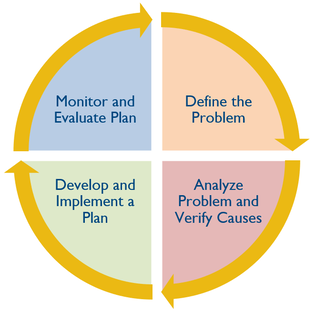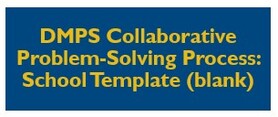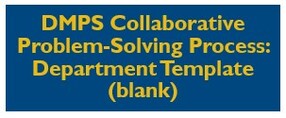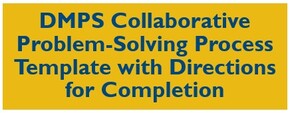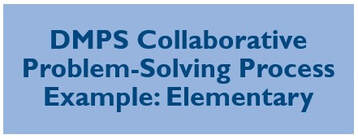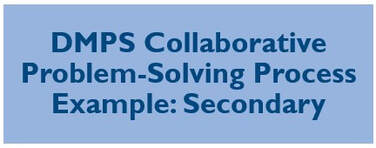|
Continuous School Improvement Through the Collaborative Problem-Solving Process
A Multi-Tiered System of Supports (MTSS) is a term used to describe an evidence-based model of education that uses data-driven problem-solving to integrate academic and behavioral instruction and intervention. To make decisions to implement the system of supports, the use of a structured, data-driven problem-solving process is a critical component of support to assure that each of the tiers included in the MTSS model is constructed in response to the specific needs of the students. As we examine district data, we are committed to keeping an equity focus on how we serve students from all groups and determine their needs. Additionally, we must be inclusive of all voices through the problem-solving process and believe that when we engage students, families, and the community as authentic education partners, the learning becomes more dynamic, and students can grow academically, socially, and emotionally. Equity, inclusiveness, continuous improvement, and evidence-based decision-making should be foundational to all DMPS structures. |
Schools: Upload/edit your working version of your school DMPS Collaborative Problem-Solving Process template for Continuous School Improvement here:
DMPS Collaborative Problem-Solving Process Resources
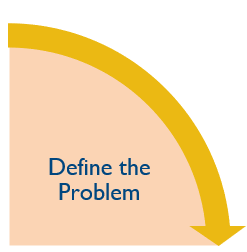
Step 1: Define the Problem
This step focuses on examining existing data and drawing inferences from that data in order to define a problem as the measurable difference between the desired outcome (or goal) and the current/actual outcome. Through discussions based on the inquiry questions included on the template, the potential problem statement/opportunity clarifies the issues within the system and will be used to frame action solutions.
Resources:
FAST Analysis
School Goals
Iowa's School Performance Profiles
This step focuses on examining existing data and drawing inferences from that data in order to define a problem as the measurable difference between the desired outcome (or goal) and the current/actual outcome. Through discussions based on the inquiry questions included on the template, the potential problem statement/opportunity clarifies the issues within the system and will be used to frame action solutions.
Resources:
FAST Analysis
School Goals
Iowa's School Performance Profiles
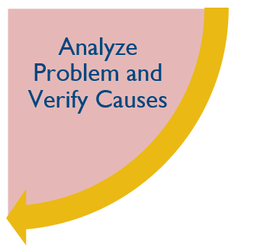
Step 2: Analyze Problem and Verify Causes
Based on available data (gathered through review, interview, observation, testing), why do you think the desired effect is not occurring? In this step, participants will generate potential causes related to the problem statement (step 2a) and gather relevant information to verify contributing factors to the problem (step 2b). Causes may be related to SAMI or other methods of verification (SCIL). The verified cause(s) will inform the Theory of Action (step 3). Stakeholder voice is called out on the template as a reminder to be inclusive of all voice through the problem-solving process. Stakeholder perspective are critical to accurately identifying the cause of issues—we cannot assume that all knowledge is held by educators and school staff.
Resources:
SAMI (Self-Assessment of MTSS Implementation)
Canvas Course: Utilizing the SAMI to Deepen Your School's MTSS
SCIL/RIOT Matrix
SCIL Handout
Staff Beliefs Survey - p. 26 (Iowa Department of Education)
Based on available data (gathered through review, interview, observation, testing), why do you think the desired effect is not occurring? In this step, participants will generate potential causes related to the problem statement (step 2a) and gather relevant information to verify contributing factors to the problem (step 2b). Causes may be related to SAMI or other methods of verification (SCIL). The verified cause(s) will inform the Theory of Action (step 3). Stakeholder voice is called out on the template as a reminder to be inclusive of all voice through the problem-solving process. Stakeholder perspective are critical to accurately identifying the cause of issues—we cannot assume that all knowledge is held by educators and school staff.
Resources:
SAMI (Self-Assessment of MTSS Implementation)
Canvas Course: Utilizing the SAMI to Deepen Your School's MTSS
SCIL/RIOT Matrix
SCIL Handout
Staff Beliefs Survey - p. 26 (Iowa Department of Education)

Step 3: Development and Implement a Plan
A theory of action is developed to frame the outcomes and high leverage action steps that address the verified problem statement. The theory of action articulates beliefs about how to most effectively to make system wide improvement and describes the path from the current state (problem statement with verified cause) to the desired state (the goal).
Resources:
Theory of Action and Definitions
A theory of action is developed to frame the outcomes and high leverage action steps that address the verified problem statement. The theory of action articulates beliefs about how to most effectively to make system wide improvement and describes the path from the current state (problem statement with verified cause) to the desired state (the goal).
Resources:
Theory of Action and Definitions
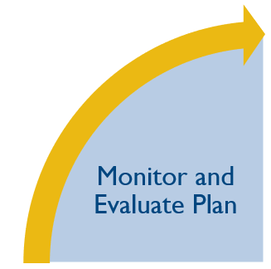
Step 4: Monitor and Evaluate Plan
Teams actively monitor their action through an action board or other action planning tool. A cadence is also set for reviewing and evaluating the plan from both an outcome and implementation lens. Based on monitoring, plans are adjusted accordingly, creating the continuous improvement loop.
Teams actively monitor their action through an action board or other action planning tool. A cadence is also set for reviewing and evaluating the plan from both an outcome and implementation lens. Based on monitoring, plans are adjusted accordingly, creating the continuous improvement loop.
General MTSS (Multi-Tiered System of Supports) Information
MTSS Overview (Heartland AEA)
MTSS Concept Map (Heartland AEA)
Canvas Course: Utilizing the SAMI to Deepen Your School's MTSS
MTSS Overview (Heartland AEA)
MTSS Concept Map (Heartland AEA)
Canvas Course: Utilizing the SAMI to Deepen Your School's MTSS
